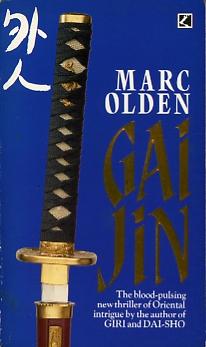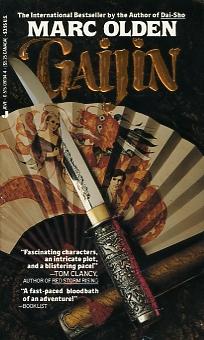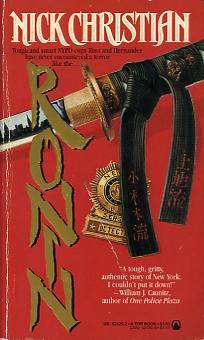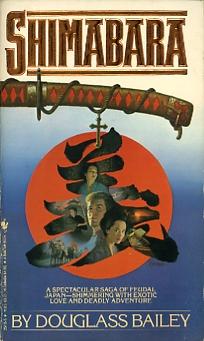Japan in pulp
Bushido, crime, and religious romance
By William Wetherall
A review of three novels
Douglass Bailey, Shimabara, 1986
Nick Christian, Ronin, 1986
Marc Olden, Gaijin, 1986
A version of this article appeared in two parts as
"Japan in Pulp (1): Bushido and Crime" in
Asahi Evening News, 4 December 1986, page 6
"Japan in Pulp (2): The Son of Shogun" in
Asahi Evening News, 11 December 1986, page 6
A longer version of Part 1 later appeared as
"Japan as seen in recent pulp fiction" in
The Japan Times, 25 March 1987, page 12 (Focus)
Marc Olden Give a monkey 600 years to type one group of any six letters every minute, without repetition and regardless of meaning, and gaijin will appear somewhere on the list of 300 million combinations. Marc Olden, of course, is no monkey. It took him only a few years to begin to ape the titles of movies like "The Yakuza" and novels like Shogun (Clavell, 1975). The last of the eight volumes of the Black Samurai series that he began cranking out in 1974 when ethnic-flavored martial-arts pulps were in vogue was entitled The Katana (1975). Giri (1982) and Dai-Sho (1983) came after an interlude of flirtation with non-Asian themes in The Harker File (1975) and Poe Must Die (1978). By the time Olden had returned to the lucrative oriental genre, the paperback fiction market had seen dozens of other Shogun pretenders with simple titles related to Japan. Gaijin is one of those stories in which the hero is only half-good and the villain is only half-evil. The latter, English aristocrat Rupert de Jongh, is ostracized by his peers when he fights against the "white only" rules of British clubs on behalf of a Japanese friend, rejects his own country and ends up a Japanese agent in Germany. During the war, he earns the lifelong enmity of American code-breaker Alexis Bendor when he kills her comrades and lops off one of her ears. When the war ends, de Jongh becomes Yamaga Razan -- "Yamaga, after the man instrumental in developing bushido, code of the feudal warrior; Ranzan, after the philosopher and adviser to the Tokugawa shoguns." As the boss of Japan's largest yakuza gang, he "wielded power with absolute energy, and terror." Forty years later, de Jongh and Alexis sight each other in Hawaii and their rivalry resumes. Heroically helping Alexis defend and avenge herself is her son Simon, born in California, raised in Hawaii, a golden boy athlete who had learned "the ancient principles of Mikkyo" as well as karate and ninjutsu from a Japanese American who had been his mother's lover. Society thinks that Simon in a businessman, but her had been a thief since finishing a Vietnam tour with a special CIA unit, Simon is addicted to stealing for the excitement rather than the money. His victims are wealthy East Coast hypocrites what deserve to be ripped off by a Robinhood ninja who can will himself unseen. The story is just implausible enough for a worst-of-the-year Hollywood film, and Olden's asides on Japanese culture and behavior are down to his usual standards. When all is read and thrown out with the trash, what sticks in the bowels is the fantasy of being a Supergaijin who can roam almighty on Japanese turf. Though de Jongh bore a Japanese name, "He was the gaijin and he did as he pleased." For "Even the most xenophobic Japanese had been forced to admit how good he was . . . And because he was as merciless as any feudal warrior, he had made the word gaijin a term of respect, a word to be feared." He lived up to his vows because "he was more Japanese than the Japanese." But the Supergaijin who proves that things Japanese are scrutable, and that Westerners can pass as Japanese, must remain an illusion even in popular fiction. As hinted through the deja vu that de Jongh feels each time he encounters something "new" about Japan, and through flashbacks in his dreams, he is not really a Westerner but a reincarnation of a 17th century samurai. Something to ponder the next time you imagine your outlandish self flashing a Japanese passport with impunity. |
Nick Christian Ronin is a martial arts crime farce set in New York. It's chief villain is Prince Hiroo Matsushima, born in 1927 the last of a samurai family descended directly from Tokugawa Ieyasu. no one calls him Prince now, for "That had been forbidden since MacArthur. But everyone knew that after the imperial family itself, the Matsushimas were the most noble." People would think Matsushima an actor or a madman if he were to dress like the samurai he wants to be.
"I was born a samurai in a world that no longer treasures their ways," the Mishima-like Matsushima laments. he feels that "the brunt of the changing tides in Japanese history had fallen in unequal measure on the shoulders of his family." He thinks that "It had become the policy of the Japanese government, and of the business community of Japan, to exact a victory tax from the United States and its people." The alienated, obsessive-compulsive, manic-depressive businessman-cum-ronin desperately wants to keep bushido going. But since "There were no other Japanese in New York yearning to return to the ways of their ancestors," Matsushima recruits twelve delinquent blacks, whites, and Puerto Ricans, gives them "strength through learning -- Zen and the martial arts -- the way of the samurai." They are taught that "To live like a samurai you cannot fear death." Though Matsushima must keep his double life secret, "the gods knew that he was the daimyo with the smallest constituency in the world." His philosophy was "a unique blend of Zen Buddhist self-realization, and [his] borrowings from Alcoholics Anonymous." But his clan members needed risk and reward, and "For the samurai warrior in New York City in the 1980s, the only open road was crime." Matsushima dislikes all geigin (Christian's corruption of gaijin). "His nose wrinkled at the thought of beefy white hands and beefy white faces, of the smells of barnyard veiled by the cheap scent of aftershave." Such visceral disdain for the racial kin of "MacArthur, the white shogun" proves Matsushima's undoing. His most immaculate plans are foiled by homicide Sergeant Arnold Ross, a martial arts expert who is clumsier and cruder than Matsushima, but is smart enough to trace some cadavers to his disciples and swing his euphoria back to suicide. Christian seems to have anticipated Prime Minister Nakasone's remarks about American minorities. Matsushima's most successful disciple is a sensitive and reflective Puerto Rican orphan named Willie Lopez. In the end, but too late, the convert sees through his master's morbid philosophy. Ronin, like Gaijin, was probably written with film rights in mind, though its story is more poorly told, and it reeks of the yellow peril paranoia evident in recent potboilers like Olden's Dai-Sho (1983), Steven Schlossstein's Kensei (1983), John Brown's Zaibatsu (1983), and Eric Van Lustbader's The Miko (1984). Both Ronin and Gaijin, though are recommendable as good examples of how Japan continues to be portrayed in American pulp fiction. Japanese can hardly be blamed for not liking such books, however much their own popular culture is similarly filled with stereotypes and distortions in connection with other peoples. |
Douglass Bailey James Clavell's Shogun (1975) has inspired many Japan novels, but unfortunately few have been better as stories or superior as cultural guides. Among these Shogun successors, most of which have been set in more recent times, none comes closer to the same period and even theme as Douglass Bailey's Shimabara (1986). Clavell's hero, Blackthorne, is an English pilot of a Dutch ship which lands in Japan. Mariko, the heroine, is the Christian wife of a feudal lord. Though modeled after historical figures who never met in real life, Blackthorne and Mariko fall in love, and he survives a battle in which she dies in his arms. The most Shogunesque of Bailey's two heroes and two heroines are less historical and more tragic. Jan Kriek is a half-Dutch, half-Portuguese Jesuit seminarian who has mastered Japanese in Lisbon. Maria is the daughter of a Christian daimyo who has sent her to Lisbon with a secret message which Kriek deciphers. Christians in Japan are in a desperate situation and need more guns. Kriek is ordered to sneak himself into Japan as a Dutch seaman, on mission to return to the fold or forfeit Father Alcala, a renegade brother who was "fomenting rebellions among Christian farmers and forging secret alliances, all without the sanction of the Church." Karma bustingKriek celibately falls in love with the single-candle-backlit silhouette of Maria's "beautifully sculpted body" even before he meets her in person. While tutoring him, she finds in his company a comfort she cannot attribute only to the fact that he speaks her language. On the voyage to Japan, before landing in Macao where he is to take his final vows, Kriek says "If there's a chance for us, say so." Maria explains: "I'm a samurai -- the daughter of a daimyo. What you're suggesting is unthinkable. I belong to my family, and you belong to the Church. Nothing either of us feels can change that." Karma-buster Bailey, of course, bribes fate to bring them together in all possible ways before they and as many as 40,000 other Christian insurgents are martyred at Hara Castle on Shimabara peninsula. The other closet lovers on Bailey's crowded stage are more fortunate. Jubei and Akane, two samurai fencers-cum-ninja, are raised as brother and sister. Only the reader must suffer from knowing what each feels about the other, and how each bears a separate burden of incestuous guilt for naught. For only the reader knows that the trite melodramatic formula obliges Bailey to resolve the conflict. Akane inadvertently learns about her adoption from none other than Miyamoto Musashi, whose son Iori she has just agreed to marry, not because she loves him though he is a good man, but because she thinks it is time to get rid of the "destructive illusions" about Jubei. Akane's "emotional limbo" continues until Bailey gives her an opportunity to see if Jubei has been on the same hook. When the truth frees their passions from "all those years of guilt and denial," Bailey unkindly separates them, although the formula anticipates that by the end they will be reunited. Circumstances, however, force them to leave Edo (now Tokyo) for Ezo "to live among the hairy Ainu." Virginal pretextsBailey's anti-hero is Prince Sanjo, a homosexual ninja who persuades Father Alcala and Lord Arima (Maria's father) to join him in a plot to overthrow the Tokugawa clan and restore power to the emperor. if successful, Christians would be allowed to worship their god without fear of persecution. Sanjo coopts Alcala by letting the lustful priest rape princess Yugiri, his virgin wife, in his presence. Yugiri gives birth to Amakusa Shiro, the Tendo (Child of God) whom Alcala has prophesied would come to rescue Japan's Christians. Then she becomes a vengeful sorceress. Lord Arima solves both his financial and political problems by arranging for Maria to marry Sanjo. Though Maria knows all about Sanjo's perversions and would rather die than marry him she does her filial duty but vows to commit seppuku if Sanjo tries to consummate the marriage. Sanjo never gives Maria the pretext she needs to end her misery, yet when she is raped by a ronin who was "only a stranger" she is too obsessed with finding Kriek to think of killing herself. Finally reunited with the man she had "tucked away in the virgin womb of her imagination," she tells him how the ronin "brutalized her body and spirit." And within two pages Kriek "unconsciously slips into his native Portuguese" and makes love to her, and "the sound of his voice transcended language . . . and . . . the feel of him inside her . . . was as if she had been taken for the first time." Novelistic liesThough Bailey emulates Clavell's "This is the key to Japan, neh?" dialogue style, unlike Clavell he tries to justify his (apparently) first novel with pedagogic pretensions. Before the story he begins, Bailey acknowledges his Japanese wife "whose Japanese spirit animates these pages" and thanks a Japanese friend "for his generous help in constructing the historical framework of this novel." Bailey begins the author's note at the end of the observations: "Someone once described the novelist as a liar who always tries to tell the truth. In that spirit I set out to create a fictional story that tells the truth about a fascinating period in Japanese history." But "since fictional and non-fictional characters mingle freely throughout" the novel "I compiled a list of the historical personages who appear in the story as a guide for the reader." The list of 13 characters is followed by another qualification: "Although I took great pains to represent these characters as they are depicted in both history and folklore, and to wrap the story around actual historical events, this work does not pretend to be history. But, inasmuch as it succeeds in conveying a sense of the true nature of those extraordinary times -- to that degree truth has been served." All of this is very misleading. Even Bailey's most "historical" characters are unworthy of the name, and some key dates are wrong. While Shogun expands five months of 1600 into 1,200 pages, Shimabara (except for the prologue which is set in 1615) compresses the six-year period from 1630 to 1635 into less than 400 pages. Shogun virtually ends with the death of Mariko Toda (historical Gracia Hosokawa) in her family's mansion near Osaka Castle in 1600; Shimabara begins with the suicide of Toyotomi Hideyori's wife Lady Sen in the 1615 siege of Osaka Castle, though she actually died of natural causes in 1666. Shimabara ends with the great rebellion from which the novel takes its name, though Bailey places it three years earlier than its dates in real history, 1637-1638. But if Bailey's ultimate aim is the same as Clavell's stated aim -- to give his readers pleasure and escape (Newsweek, August 24, 1981) -- and if, as a reader, that is all one wants, then Shimabara may be bearable. |



